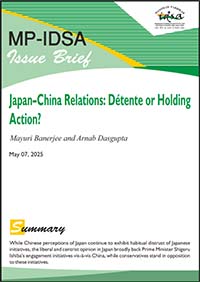Japan–China Relations: Détente or Holding Action?
- May 07, 2025 |
- Issue Brief
Summary
While Chinese perceptions of Japan continue to exhibit habitual distrust of Japanese initiatives, the liberal and centrist opinion in Japan broadly back Prime Minister Shigeru Ishiba’s engagement initiatives vis-à-vis China, while conservatives stand in opposition to these initiatives.
China–Japan ties appear to be caught in a complex interplay of diplomatic manoeuvring and persistent strategic tensions. Towards the end of March 2025, as Japan and China held the Sixth Economic Dialogue in Tokyo after a gap of six years, Chinese and Japanese coastguards engaged in a tense stand-off in the contested waters of the disputed Diaoyu/Senkaku islands.[1] While on the one hand, the two sides discussed ways to implement practical cooperation in the economic field, the armed forces of the two countries accused each other of stoking tensions.[2]
The dichotomy extended to diplomatic interactions as well. Beijing protested Tokyo’s appointment of a former Japanese military chief as adviser to the Taiwanese government.[3] Further, following Minister of Foreign Affairs, China, Wang Yi and Japanese Prime Minister Shigeru Ishiba’s discussions in Tokyo regarding enhancing the strategic relationship for mutual benefit, Japan protested a Chinese statement about Ishiba’s purported affirmation that Japan ‘respected’ China’s position.[4] The Brief places in context the Japan–China strategic and diplomatic divergences even as attempts to steer the bilateral ties towards a positive trajectory are being pursued.
Developments in China–Japan Ties
Following continuous acrimony and diplomatic tensions witnessed during the years of the Kishida administration, China–Japan bilateral relations showed signs of a thaw when Chinese Premier Li Qiang and Japanese Prime Minister Shigeru Ishiba pledged to stabilise ties in October 2024.[5] Thereafter, Wang Yi, who is a member of the political bureau of the CPC Central Committee and Takeo Akiba, Japan’s Chief National Security Adviser, agreed to maintain dialogue at various levels of the government on both sides in extensive talks in November 2024.[6]
Notably, a series of high-level exchanges were organised in an attempt to reset bilateral ties. For instance, Chinese President Xi Jinping and Japanese PM Shigeru Ishiba met on the side-lines of the 31st APEC Economic Leaders’ Meeting in Lima in November 2024[7] and Japanese Foreign Minister Takeshi Iwaya visited Beijing to hold talks with Li Qiang and Liu Jianchiao,[8] Minister of International Department of the CPC in December 2024. Further, China and Japan exchanged military delegations and held bilateral talks between political leaders in January 2025. Finally, the Sixth Economic Dialogue and Wang Yi’s visit to Tokyo added further momentum to the advancement of bilateral ties.[9]
However, concurrent to these positive developments, underlying strains in China–Japan bilateral ties were also visible. Shortly after Ishiba assumed office, Japanese Foreign Minister Iwaya in a telephone conversation with Chinese Foreign Minister Wang Yi expressed Tokyo’s concerns about the situation in East China Sea and China’s intensified military activities in the region.[10] Also, amidst talks of stabilising bilateral ties and deepening strategic cooperation with China, Beijing maintained military pressure around the disputed Senkaku/Diaoyu islands while Defence Minister Gen Nakatani sought US support for Japanese claims on the islands.[11]
Similarly, as the two sides moved to establish dialogue at various levels of the government, tensions persisted over Japan’s improving ties with Taiwan, Tokyo’s decision to deploy long-range missiles in Kyushu and establishment of a new Joint Operations Command. The seemingly contradictory developments in Sino-Japan bilateral ties showcased cautious cooperation and signalling of willingness to defend core interests. As could be assessed from select writings in Chinese and Japanese news media, enduring threat perceptions and stereotyping are major factors shaping these developments.
Chinese observations
From the Chinese perspective, while there were positive analyses of the Ishiba administration’s China policy, it was overshadowed by concerns and stereotyped analyses about Japan–US alliance and Japan’s military modernisation. Chinese analysts noted that since coming to power, the Ishiba administration, in a bid to reverse the downward spiral in bilateral ties witnessed during the previous administrations, gestured towards stabilising ties with China through pragmatic cooperation.[12] In that context, Ishiba’s willingness to visit China, sending of a couple of hand-written letters to Xi, facilitating revival of exchanges at various levels of the government and dialogues regarding political, economic and cultural cooperation were seen as signs that the new government in Tokyo was attempting to promote a positive momentum in bilateral ties.[13]
Some commentators argued that Ishiba, being the disciple of former Japanese Prime Minister Kakuei Tanaka, who started the Sino-Japanese normalisation process, was expected to adopt a conciliatory approach towards China.[14] Further, he could also push for a more strategically autonomous policy vis-à-vis the US and seek to balance Japan’s relations with both China and the US.[15] Shigeru Ishiba unlike his predecessors was seen as not having deep ties with the US due to his advocacy for a reciprocal status with Washington.
However, notwithstanding these positive assessments, Chinese strategists and foreign policy observers contended that while the current warmth in Sino-Japan bilateral ties is driven partly by Trump’s trade policies and Japan’s own economic downturn, this trend is reversible as Japan’s China policy is dictated by the US.[16] Owing to Tokyo’s dependence on the US for security and economic matters, Japan has not been able to get rid of US interference in its foreign and defence policy. In the past it acted as a “pawn” for the US to contain China, and following the US lead, designated China as the “greatest strategic challenge ever”.[17]
In this context, Chinese analysts warned that Japan–China relations, despite the positive turn, can deteriorate if Trump coerces Japan to align against China. Therefore, once the US takes targeted actions in the Asia-Pacific region, China–Japan cooperation might face serious tests.[18] Some commentators also argued that although Shigeru Ishiba has tried to balance Japan’s relations with China and the US, he is not a strong Prime Minister. The ‘right wing forces’ close to the US are largely in charge of Japan’s foreign policy and espouse the US’ China threat theory.[19]
Accordingly, Ishiba allowing negative statements about China to appear in Japan–US joint statement, NATO Secretary General Mark Rutte’s visit to Japan to advance military cooperation, and the establishment of the Joint Operations Command are indications of the continuing strategic convergence between Japan and US in the opinion of Chinese policy observers.[20] Notably, the PLA Daily opined that in the future, the JSDF is likely to serve as a “strategic fulcrum” in the US ‘Asia-Pacific’ military system and take on a more proactive role in the second island chain region.[21] Tokyo’s strategic orientation under Ishiba of aligning with the US and using Taiwan to contain China, while maintaining a degree of stability in Sino-Japan relations, was unlikely to change.[22]
Another observer noted that while Japan and the US might have differences at the tactical level, the underlying strategy of containing China remained the same.[23] Along with concerns regarding Japan–US ties and the possibility of control of right-wing forces on Japan’s foreign policy undermining positive developments, Chinese policy observers also expressed reservations regarding Japan’s continuing military modernisation and its adverse impact on China–Japan ties. Blaming a right-wing conservative trend in Japanese politics, commentators noted that the China threat theory has emerged as ‘magic weapon’ for conservative political forces to promote constitutional amendment and strengthen the Japanese military.[24]
Thus, several Chinese analysts urged that Beijing should closely follow Japan’s military reforms, missile deployments as well as Tokyo’s increasing military and security cooperation with the US, NATO and Europe. Accusing Japan of trying to challenge the post-war international order and disturbing peace in the region, these developments were perceived as Japan’s efforts to enhance its offensive capabilities to counter China and gradually normalise its re-emergence as a “military capable” country. Referring to Japan’s history of aggression in the region, Chinese commentators opined that Tokyo’s disregard of history and rapid military advancements aimed at China would be a major impediment to development of China–Japan ties.
Japanese Perceptions
On the Japanese side, both popular and specialist opinions reveal that their understanding and interpretations of Japan–China relations largely conform to their political positionality (confirming in interesting ways the Chinese analyses of the situation). At the same time, all voices on the Japanese side clearly remain wary of Beijing’s intentions, despite acute concern over the threat to international order represented by President Trump. Two covalent trends reveal themselves in an analysis of prevailing media narratives in Japan, which influence how policymaking by the Ishiba administration is viewed by the public. The first trend concerns the respective publication’s stance towards the US in general and particularly, towards Trump. This stance in turn feeds into appreciation of the merits (or lack thereof) of engaging with Beijing.
Broadly speaking, there is a spectrum of concerns expressed across the breadth of Japanese opinion regarding President Trump’s activities in office. The most progressive-minded of the Japanese newspapers, the Asahi Shimbun, has remained harshly critical of Trump’s actions, terming them a ‘staggering disregard for rules’, and accusing his administration of ‘repeatedly attempting to manipulate global affairs by exploiting America’s immense power’.[25] This critique has only sharpened after Trump announced his ‘liberation day’ tariffs.
The Mainichi Shimbun, a more centrist newspaper, has stayed true to its orientation in refraining from overtly taking an anti-Trump stance, while clearly conveying its concerns regarding his browbeating of Japan. Its position is evident in its language, which refers merely to ‘the shared challenge of addressing the administration of US President Donald Trump’s “America First” policies’ while still expressing concern over the tariffs.[26] At the same time, it expresses concern over the ‘amplify[ing] demands’ posed by Trump on security partners and allies, expressing cautious optimism that Japan will not be a simple follower of Trump’s America First doctrine.[27]
The Yomiuri Shimbun, Japan’s mainstream conservative newspaper, is consistently concerned more with the potentiality of Chinese ‘aggression’ in Japan’s neighbourhood, a hallmark of Japanese conservativism, than with the actions of the US.[28] Thus, it has by and large remained silent on Trump’s statements against Japan. Nevertheless, in one editorial, it expressed concern about the ‘international order on the verge of collapse’, which may be read as a silent indictment of Trump’s behaviour.[29] The tariffs have further sharpened these critiques, as Japan’s national interests are directly affected by them.
It is, predictably, the Sankei Shimbun, the most conservative and far-right newspaper, that takes the most accommodative stance towards Trump. Editorials from this newspaper consistently argue that Japan must hew closely to the US line, as it befits a country benefiting from the security provided by the US–Japan Security Treaty.[30] It has continuously urged senior officials from the Ishiba administration to prefer Washington over all other destinations for visits, and has remained curiously silent over the tariffs, restricting itself to a call to dialogue and exchange of views with US counterparts.
The degree of concern over Trump’s actions and their implications on the world stage have a direct correlation with the respective publication’s stance on the value of Japan–China relations, as explained above. In sum, it may be noted that the degree of hostility to Trump’s actions is a sure indicator of the degree of sympathy accorded to engagement with Beijing. As expected, the Asahi Shimbun is most in favour of engagement with China. While it continues to express significant alarm and concern regarding Chinese military expansion and aggressive activities around the Senkaku/Diaoyu Islands, it expresses an optimistic view of China nonetheless.
The Asahi Shimbun’s tone is most moralistic, seeking from China a normative commitment befitting a great power of transparency, consistency and non-aggression. While noting that there are many points of contention between the two countries, the newspaper is also most in favour of sustained engagement with Beijing, not only bilaterally but also trilaterally with Seoul.[31] The reasoning behind its endorsement is the need to maintain dialogue mechanisms to gradually solve outstanding bilateral issues, which it argues are a natural facet of being neighbourly nations. Increasing tensions with Washington provide a crucial impelling factor in this objective.
The centrist Mainichi also broadly welcomes the thaw in relations with Beijing, but expresses a much more cautious stance. The newspaper clearly expresses a desire to see the three countries acting as forces for stability in light of Washington’s retreat. It is also in favour of an improving relationship with China, its largest trading partner. At the same time, however, it is chary of trusting Beijing completely, noting the litany of bilateral issues pending between the two countries. Nevertheless, it too argues that the solution to the impasse is more dialogue. Interesting to note here is that this newspaper argues that China has pragmatic motives it wishes to pursue in East Asia, namely ‘to unsettle the US-led alliance system’ by ‘taking a strong stance against protectionism’.[32]
The mainstream conservative Yomiuri is broadly laudatory towards the trilateral engagement too, expressing appreciation for the three foreign ministers’ commitment to maintaining regional stability. However, it does not allow that to obscure the fact that China’s behaviour in the region remains ‘irresponsible’, arguing that should it continue on its current course, Beijing’s actions ‘will only accelerate the destabilisation of the international situation’.[33] Implicit in this argument is its expectation that Beijing will play a stabilising role in light of the US’ increasingly isolationist tendencies. For this, the editorials argue that China must abandon its threat to Taiwan, cease supporting Russia in the Ukraine crisis and halt its attempts to forcibly change the status quo in the East and South China Seas.
The most hostile stance towards China is expressed by the Sankei Shimbun, as is par for the course. Its editorials express thoroughgoing criticism and disbelief of China’s desire for engagement, while arguing that Beijing’s attempts to pursue good relations with its neighbours are merely the public arm of an undeclared policy of driving a wedge between the US and its allies.[34] It points to the increase in Chinese activity around the Senkakus to underscore its point that the government of Japan is essentially being hoodwinked by the Chinese when the latter claim they want dialogue between the two countries. Interestingly, this newspaper urges Japanese representatives visiting China to stridently dispute points of contention, and recommends they ‘openly express…harsh feelings the Japanese people today harbour towards China’.[35] This latter point is interesting, as it essentially imputes lack of accountability to ‘the Japanese people’ on the part of their elected representatives as they pursue engagement with China.
Conclusion
Overall, the analyses on the Chinese side exhibited a lot more interest about the future trajectory of the bilateral ties, Japan’s intent, the Japan–US alliance and Japanese military modernisation, than the Japanese, on similar issues. However, both sides, despite their willingness to engage (primarily on trade), appear cautious and restrained. Chinese analysts argue that Washington’s continued influence over Japan’s foreign and security policy, the dominance of pro-US right wing forces and Ishiba’s lack of political strength require a gradual approach towards advancing bilateral ties.
Moreover, Japan’s military modernisation to gain so-called ‘offensive’ capabilities and increasing military and security cooperation with the Western powers, largely with an eye to counter China, signal that Tokyo seeks to contain China’s rise through third-party alliances. On the other hand, it also seeks to maintain trade cooperation for economic benefits. Therefore, China has to be vigilant with regard to Japan’s foreign and defence policy in the region.
Mirroring the Chinese caution, Japanese strategists have also been at pains to point to the difficulties inherent in engagement with Beijing. In an obverse of the Chinese position, they argue that it is China, given its economic and military weight, that needs to act responsibly and work to stabilise the international situation in light of the Trumpist retreat from international hegemony. They highlight the simultaneous incursion by Chinese coastguard vessels into waters around the Senkaku Islands in the immediate aftermath of the Trilateral Foreign Ministers’ Meeting, as well as charges of older vintage such as China’s support to Russia and its enabling role in shielding North Korea from international scrutiny over its violations of UN-imposed sanctions, as evidence of the insincerity of Beijing’s commitment.
However, while more liberal-minded analyses counsel patience and instrumental cooperation, radical voices on the far right urge a more strident stand by pointing to the fundamental unsuitability of the Communist Party of China as an honest broker in the improvement of ties. These two stances shape support for the Ishiba administration’s China policy. Broadly speaking, liberal and centrist opinion backs Ishiba’s engagement in broad terms, while the arch conservative Sankei and ideologues affiliated with it oppose it. This is an interesting dynamic, especially in light of Chinese assessments discussed above.
While Chinese analysts argue that there exists a distinct ‘right-wing view’ in Japanese opinion, they are extremely off-base when gauging the amount of influence that view has on Japanese foreign policy. In turn, this offers fascinating glimpses into Chinese perceptions of Japan, especially their habitual distrust of Japanese initiatives, which confirms observations made by scholars in recent years.[36]
In the foreseeable future, owing to conflicting strategic interests coupled with mutual threat perceptions and stereotyping, Sino-Japan relations are unlikely to witness significant developments. However, external pressures such as more coercive trade policies from the Trump administration or other geo-strategic issues, could lead them to cooperate more closely in certain limited spheres such as trade and technology. Protracted issues such as the territorial dispute over the Senkaku/Diaoyu islands, Japan’s military modernisation and China’s assertive military posture would continue to be conflict points. Consequently, both countries are likely to continue to project deterrence capabilities to manage tensions while taking care, not to escalate further.
Views expressed are of the author and do not necessarily reflect the views of the Manohar Parrikar IDSA or of the Government of India.
[1] Takahashi Kosuke, “China Coast Guard Makes Its Longest Intrusion Into Disputed East China Sea Waters”, The Diplomat, 25 March 2025.
[2] “Chinese Coast Guards Expelled Japanese Vessels that Illegally Entered China’s Territorial Waters Off the Diaoyu Islands in Accordance with the Law”, China Coast Guard, 24 March 2025; Enoch Wong, “China Coastguard Drives off Japanese Fishing Boats in Escalating Island Dispute”, SCMP, 25 March 2025.
[3] Liu Zhen, “Beijing Protests Over Former Japanese Military Chief’s Taiwan Adviser Role”, SCMP, 21 March 2025.
[4] “Japan Protests Chinese Government Statement it Says Misquoted PM Ishiba”, The Business Standard, 24 March 2025.
[5] Keita Nakamura and Maya Kaneko, “Japan PM Ishiba, China’s Li Agree to Seek Mutually Beneficial Ties”, Kyodo News, 10 October 2024.
[6] “China’s Wang, Japan Security Adviser Agree to Keep Bilateral Dialogue”, Kyodo News, 4 November 2024.
[7] “Xi Jinping Meets with Japanese Prime Minister Shigeru Ishiba”, Ministry of Foreign Affairs, The People’s Republic of China, 16 November 2024.
[8] “Foreign Minister IWAYA’s Visit to China”, Ministry of Foreign Affairs of Japan, 25 December 2024.
[9] “China and Japan Hold the Sixth High-Level Economic Dialogue”, Ministry of Foreign Affairs, The People’s Republic of China, 22 March 2025.
[10] “Japan-China Foreign Ministers’ Telephone Talk”, Ministry of Foreign Affairs of Japan, 9 October 2024.
[11] Julian Ryall, “Japan Weighs Trust in Trump as US Says Defence of Diaoyu Islands Rock Solid”, SCMP, 3 February 2025.
[12] “China-Japan Relations Have an Opportunity to Improve”, Southern News Network, 5 January 2025.
[13] Ma Ziqian Jia Yimeng, “Multi-level Intensive Interaction China-Japan Relations Present a Warm New Year”, China Youth Daily, 17 January 2025.
[14] “China-Japan Relations Have an Opportunity to Improve”, no. 12; Zhang Diancheng, “It is Easy to Change the Country but Difficult to Change one’s Nature? Japan Does Not Allow the Mainland to Unify Taiwan, and China Has Made it Clear”, Sohu, 12 February 2025; Zhu Yuehong, “How Will Shigeru Ishiba’s “Upset” Election as President of Japan’s Liberal Democratic Party Affect Sino-Japanese Relations?”, Beijing News, 29 September 2024.
[15] Zhu Yuehong, “How Will Shigeru Ishiba’s ‘Upset’ Election as President of Japan’s Liberal Democratic Party Affect Sino-Japanese Relations?”, Beijing News, 29 September 2024; Hong Yunxin, “Shigeru Shi Po Rejects the U.S. Demand for “More Money”: Demonstrating “Strategic Autonomy” or “Tactical Differences?“, The Paper, 3 March 2025.
[16] Tang Hua, “To Build Stable China-Japan Relations, the Japanese Side Must Abandon its Speculative Mentality”, China Online Review, 26 February 2025.
[17] Ibid.; Pan Wanli, “Can the U.S. Tariff Stick Wake Up Japan?”, China.com, 4 April 2025.
[18] Qiu Zhenhai, “After Four Years, the Chinese Foreign Minister Visited Japan Again, China-Japan Relations Warmed Up, and the Dawn of East Asia’s Economic Rise Appeared?”, Toutiao.com, 26 March 2025.
[19] Bai Ruchun, “The Improvement of Sino-Japanese Relations is On the Right Track”, Institute of Japanese Studies, CASS, 2 February 2025; “China-Japan Relations Have an Opportunity to Improve”, no. 12; Xiang Haoyu, “The APEC Covenant Has Led to the Steady Improvement of China-Japan Relations”, China Diplomacy, 12 December 2024; Huang Jiayu and Ge Yawei, “Vigilance Against Japan’s Move to a ‘Capable Country’“, China Military Network-People’s Liberation Army Daily, 26 March 2025.
[20] Aogu Zhenxin, “Shigeru Ishiba Surprised the Whole World! Is the Warming of Sino-Japanese Relations Just a Flash in the Pan?”, NetEase, 2 February 2025; “Approaching NATO, what is Japan’s heart?”, Xinhuanet, 18 April 2025; Huang Jiayu and Ge Yawei, “Vigilance Against Japan’s Move to a “Capable Country“, no. 19.
[21] Huang Jiayu and Ge Yawei, “Vigilance Against Japan’s Move to a “Capable Country“, no. 19.
[22] Xing Xiaojing, “Shigeru Ishiba’s Victory Over the China Hawks, Will Sino-Japanese Relations Improve?”, Global Times, 27 September 2024.
[23] Hong Yunxin, “Shigeru Shi Po Rejects the U.S. Demand for ‘More Money’: Demonstrating ‘Strategic Autonomy’ or ‘Tactical Differences?’“, The Paper, 3 March 2025.
[24] Xiang Haoyu, “The APEC Covenant Has Led to the Steady Improvement of China-Japan Relations”, no. 19.
[25] “EDITORIAL: China Must Align its Diplomacy with its Role as a Global Power”, The Asahi Shimbun, 13 March 2025.
[26] “Editorial: Japan, China, S. Korea Must Enhance Cooperation for Asia’s Stability”, The Mainichi Shimbun, 25 March 2025.
[27] “Editorial: Japan Must Avoid Becoming Front Line in US-China Rivalry”, The Mainichi Shimbun, 1 April 2025.
[28] “Chinese Military Exercises: Use of Intimidation Against Taiwan Threatens Regional Stability”, The Yomiuri Shimbun, 12 April 2025.
[29] “Trilateral Foreign Ministers Meeting: Japan, China, S. Korea Must Deepen Cooperation to Ensure Regional Stability”, The Yomiuri Shimbun, 23 March 2025.
[30] “Editorial: Why Are Japanese Politicians Heading to China But Not the US?”, The Sankei Shimbun, 14 January 2025.
[31] “Editorial: With World Order Shaken, Unity Vital for Japan, China, S. Korea”, The Asahi Shimbun, 24 March 2025.
[32] “Editorial: Japan, China, S. Korea Must Enhance Cooperation for Asia’s Stability”, no. 26.
[33] “Trilateral Foreign Ministers Meeting: Japan, China, S. Korea Must Deepen Cooperation to Ensure Regional Stability”, no. 29.
[34] “Editorial: Rushing Off to China’s ‘Love Call’ is Not in Japan’s Best Interests”, The Sankei Shimbun, 24 April 2025; 田村秀男 (Hideo Tamura), “【第1241回】石破首相は日中韓FTAの罠にはまるな” [No. 1241: PM Ishiba, Don’t Get Caught in the Trap of Japan-China-South Korea FTA], 国家基本問題研究所 [Japan Institute for National Fundamentals], 7 April 2025.
[35] “Editorial: Rushing Off to China’s ‘Love Call’ is Not in Japan’s Best Interests”, no. 34.
[36] See Amrita Jash, China’s Japan Policy: Learning from the Past, Palgrave Macmillan, Switzerland, 2024.







